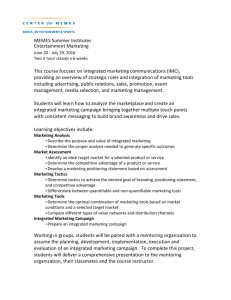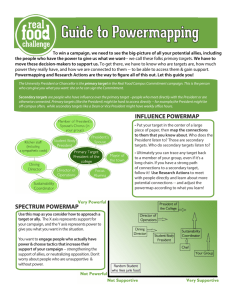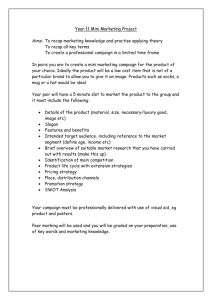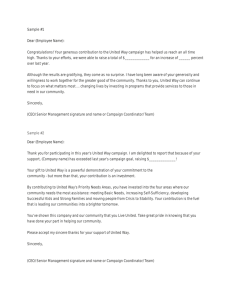Social Change/Community Organizing
advertisement
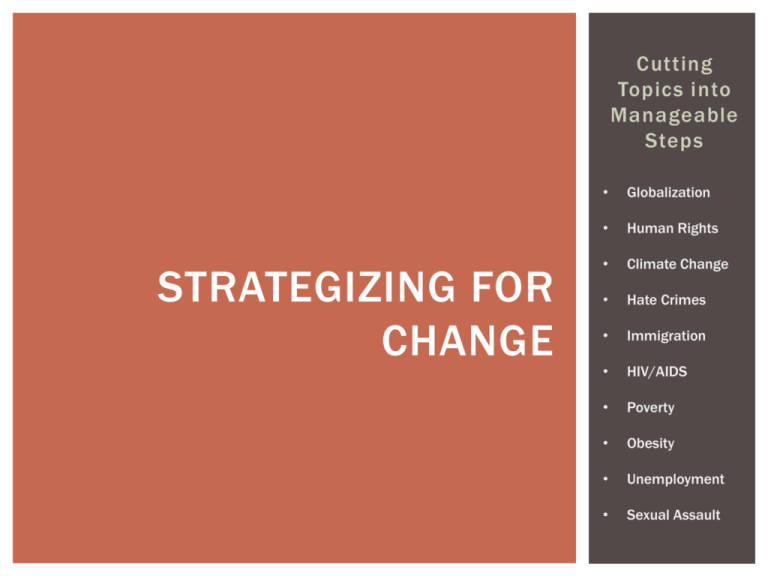
Cutting Topics into Manageable Steps STRATEGIZING FOR CHANGE • Globalization • Human Rights • Climate Change • Hate Crimes • Immigration • HIV/AIDS • Poverty • Obesity • Unemployment • Sexual Assault SEQUENCE FOR DEVELOPING STRATEGY Strategy* Campaign Scope & Goals* Vision Situational Analysis* Critical Path Analysis * We will take a closer look at these… Organizational Considerations Allies, Constituents, & Targets* Objectives* Tactics* Evaluation STRATEGY* “ A PLAN OF ACTION OR POLICY DESIGNED TO ACHIEVE A MAJOR OR OVERALL AIM 1) What do we want? (goals) 2) Who can give it to us? (audiences) 3) What do they need to hear? (messages) 4) Who do they need to hear it from? (messengers) 5) How do we get them to hear it? (delivery) 6) What have we got? (resources; strengths) 7) What do we need to develop? (challenges; gaps) 8) How do we begin? (first steps) 9) How will we know it's working, or not working? (evaluation) ” CAMPAIGN SCOPE & GOALS* “ T H E O B J E C T O F A P E R S O N ' S A M B I T I O N O R E F F O R T ; A N A I M O R D E S I R E D R E S U LT ” ‘Cut the issue’ to narrow down bigger picture problems into more manageable parts… What are all the different ways the problem is experienced? What are some ways that people interpret, respond to or campaign around the world? How is it framed by different groups? What part of the problem or bigger issue does the group intend to work on? It might be helpful to frame it as a solution or partial solution. Name the problem, identify issues and justify which one/s you plan to tackle. VISION “ T H E A B I L I T Y T O T H I N K A B O U T O R P L A N T H E F U T U R E W I T H I M AG I N AT I O N O R W I S D O M ” Who are we? What is the problem? What is our vision of change ? What objectives - or piece of our vision - are we focusing on? SITUATIONAL ANALYSIS* This exercise is used to analyze the root causes of a problem and to identify the primary consequences. The tree provides a visual structure for the analysis. Roots = Root Causes of the Problem Trunk= the Problem Branches = The Ef fects of the Problem CRITICAL PATH ANALYSIS What sequence of changes or outcomes will take you from here to the vision of your campaign goal area being resolved ? What changes need to take place? What assumptions underpin your critical path? What steps can you realistically bring about? ORGANIZATIONAL CONSIDERATIONS What organizational considerations do you need to bear in mind? What are your philosophies and policies? What are our strengths? Constraints? Consider key organizational priorities such as gender and cultural diversity, and fundraising objectives. What level of priority does this campaign have? What resources are likely to be available for this campaign? ALLIES, CONSTITUENTS, & TARGETS* Allies are the stakeholders you can work, build alliances, and share resources with. Constituents are “the community”, the people you want to side with your position and help apply pressure to your target. Your target is often a decision maker - someone who can give you the change you want ie: politicians, ministers “Who Do You Know?” Who has the power to make the change you want, and is most vulnerable to the kinds of pressure you can mount? Who are your allies? Who could be your active supporters? Who will actively oppose you? How can we reach the people in power? OBJECTIVES* “ A T H I N G A I M E D AT O R S O U G H T ; A G OA L ” SMART objectives are: S: Specific and Strategic M: Measurable A: Achievable (in the world) R: Realistic (within the capacity of your group) T: Time bound TACTICS* “ A N A C T I O N O R S T R A T E G Y C A R E F U L LY P L A N N E D T O A C H I E V E A S P E C I F I C E N D ” 1) Can you really do it? Do you have the needed people, time and resources? 2) Is it focused on either the primary or secondary target? 3) Does it put real power behind a specific demand? 4) Does it meet you organizational goals as well as your issue goals? 5) Is it outside the experience of the target? 6) Is it within the experience of your own members and are they comfortable with it? 7) Do you have enough leaders experienced enough to do it? 8) Will people enjoy participating in it? 9) Will it play positively in the media? EVALUATION “ T H E M A K I N G O F A J U D G M E N T A B O U T T H E A M O U N T, N U M B E R , O R VA L U E O F S O M E T H I N G • outputs: What quantitative results will be brought about by your activities. What will be the results? • outcomes: What changes will be brought about? • impact: What will be longer-term results or changes? • indicators: How will you know you have achieved your objectives? What are the changes that you will be able to observe? • means of verification: How can you prove these changes have occurred? • details of how and when the campaign plan will be revised. • identify who will be responsible for gathering the data for monitoring success indicators, how they will do it and how regularly reports will be completed. ” LISTEN DEEPLY REFLECT CRITICALLY STRATEGIZE EFFECTIVELY MAKE CHANGE HAPPEN Small smallwe go catch monkey!
